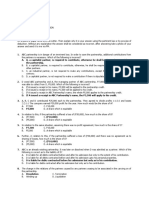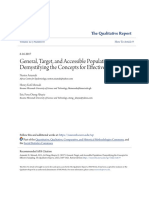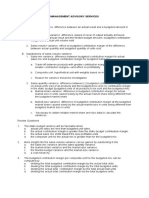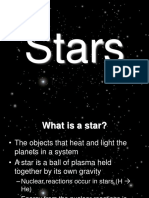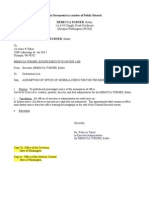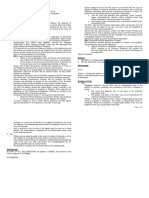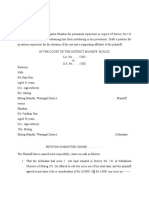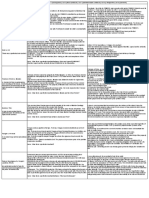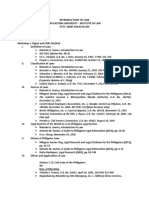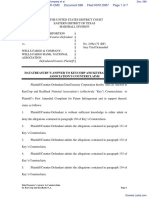0 ratings0% found this document useful (0 votes)
198 viewsReview MCQ
Review MCQ
Uploaded by
WilsonThe document defines key terms related to financial rehabilitation and insolvency proceedings in the Philippines according to Republic Act No. 10142. Some of the terms defined include debtor, creditor, claim, administrative expenses, commencement date, rehabilitation, liquidation, voluntary and involuntary proceedings, secured and unsecured claims, subsidiary, parent, and voting creditors. The act provides a legal framework for the rehabilitation or liquidation of financially distressed corporations, partnerships, and individuals.
Copyright:
© All Rights Reserved
Available Formats
Download as DOCX, PDF, TXT or read online from Scribd
Review MCQ
Review MCQ
Uploaded by
Wilson0 ratings0% found this document useful (0 votes)
198 views13 pagesThe document defines key terms related to financial rehabilitation and insolvency proceedings in the Philippines according to Republic Act No. 10142. Some of the terms defined include debtor, creditor, claim, administrative expenses, commencement date, rehabilitation, liquidation, voluntary and involuntary proceedings, secured and unsecured claims, subsidiary, parent, and voting creditors. The act provides a legal framework for the rehabilitation or liquidation of financially distressed corporations, partnerships, and individuals.
Original Description:
Hsksydbska
Original Title
Review Mcq
Copyright
© © All Rights Reserved
Available Formats
DOCX, PDF, TXT or read online from Scribd
Share this document
Did you find this document useful?
Is this content inappropriate?
The document defines key terms related to financial rehabilitation and insolvency proceedings in the Philippines according to Republic Act No. 10142. Some of the terms defined include debtor, creditor, claim, administrative expenses, commencement date, rehabilitation, liquidation, voluntary and involuntary proceedings, secured and unsecured claims, subsidiary, parent, and voting creditors. The act provides a legal framework for the rehabilitation or liquidation of financially distressed corporations, partnerships, and individuals.
Copyright:
© All Rights Reserved
Available Formats
Download as DOCX, PDF, TXT or read online from Scribd
Download as docx, pdf, or txt
0 ratings0% found this document useful (0 votes)
198 views13 pagesReview MCQ
Review MCQ
Uploaded by
WilsonThe document defines key terms related to financial rehabilitation and insolvency proceedings in the Philippines according to Republic Act No. 10142. Some of the terms defined include debtor, creditor, claim, administrative expenses, commencement date, rehabilitation, liquidation, voluntary and involuntary proceedings, secured and unsecured claims, subsidiary, parent, and voting creditors. The act provides a legal framework for the rehabilitation or liquidation of financially distressed corporations, partnerships, and individuals.
Copyright:
© All Rights Reserved
Available Formats
Download as DOCX, PDF, TXT or read online from Scribd
Download as docx, pdf, or txt
You are on page 1of 13
At a glance
Powered by AI
The document discusses definitions of key terms under the Financial Rehabilitation and Insolvency Act (FRIA) of 2010. These include types of proceedings, claims, corporations, debtors, and creditors.
The purpose of FRIA is to ensure or maintain certainty and predictability in commercial affairs, preserve and maximize the value of assets of debtors, recognize creditor rights, and ensure equitable treatment of creditors.
The different types of proceedings under FRIA include voluntary proceedings initiated by the debtor, involuntary proceedings initiated by creditors, voluntary liquidation, and involuntary liquidation.
# STATEMENTS
This Act shall be known as the "Financial
Rehabilitation and Insolvency Act (FRIA) of 2010".
A. REPUBLIC ACT NO. 10142
1
B. REPUBLIC ACT NO. 10155
C. REPUBLIC ACT NO. 10150
D. REPUBLIC ACT NO. 10100
It shall be made with a view to ensure or maintain
certainly and predictability in commercial affairs,
preserve and maximize the value of the assets of these
debtors, recognize creditor rights and respect priority
of claims, and ensure equitable treatment of creditors
2
who are similarly situated.
A. REHABILITATION
B. LIQUIDATION
C. BOTH A & B
D. NONE OF THE ABOVE
It shall refer to those reasonable and necessary
expenses incurred or arising from the filing of a
petition under the provisions of this Act.
3 A. CLAIM
B. ADMINISTRATIVE EXPENSES
C. CONTROL
D. AFFILIATE
It shall refer to a corporation that directly or
indirectly, through one or more intermediaries, is
controlled by, or is under the common control of
another corporation.
4
A. CLAIM
B. ADMINISTRATIVE EXPENSES
C. CONTROL
D. AFFILIATE
It shall refer to all claims or demands of whatever
nature or character against the debtor or its property,
whether for money or otherwise, liquidated or
unliquidated, fixed or contingent, matured or
5 unmatured, disputed or undisputed.
A. CLAIM
B. ADMINISTRATIVE EXPENSES
C. CONTROL
D. AFFILIATE
It shall refer to the power of a parent corporation to
direct or govern the financial and operating policies
of an enterprise so as to obtain benefits from its
activities.
6
A. CLAIM
B. ADMINISTRATIVE EXPENSES
C. CONTROL
D. AFFILIATE
IT shall refer to the date on which the court issues
7
the Commencement Order, which shall be retroactive to
the date of filing of the petition for voluntary or
involuntary proceedings.
A. DEBTOR
B. COMMENCEMENT DATE
C. CREDITOR
D. COMMENCEMENT ORDER
It shall refer to the order issued by the court under Section
16 of this Act.
A. DEBTOR
8
B. COMMENCEMENT DATE
C. CREDITOR
D. COMMENCEMENT ORDER
It shall refer to a sole proprietorship duly registered
with the Department of Trade and Industry (DTI), a
partnership duly registered with the Securities and
Exchange Commission (SEC), a corporation duly organized
and existing under Philippine laws, or an individual
9
debtor who has become insolvent as defined herein.
A. DEBTOR
B. COMMENCEMENT DATE
C. CREDITOR
D. COMMENCEMENT ORDER
It shall refer to a natural or juridical person which
has a claim against the debtor that arose on or before
the commencement date.
10 A. DEBTOR
B. COMMENCEMENT DATE
C. CREDITOR
D. COMMENCEMENT ORDER
It shall refer to a claim that is secured by a lien.
A. UNSECURED CLAIM
11 B. SECURED CLAIM
C. UNSECURED CREDITOR
D. SECURED CREDITOR
It shall refer to a creditor with a secured claim.
A. UNSECURED CLAIM
12 B. SECURED CLAIM
C. UNSECURED CREDITOR
D. SECURED CREDITOR
It shall refer to a claim that is not secured by a
lien.
A. UNSECURED CLAIM
13
B. SECURED CLAIM
C. UNSECURED CREDITOR
D. SECURED CREDITOR
It shall refer to a creditor with an unsecured claim.
A. UNSECURED CLAIM
14 B. SECURED CLAIM
C. UNSECURED CREDITOR
D. SECURED CREDITOR
15 It shall refer to proceedings initiated by creditors.
A. VOLUNTARY LIQUIDATION
B. VOLUNTARY PROCEEDINGS
C. INVOLUNTARY LIQUIDATION
D. INVOLUNTARY PROCEEDINGS
It shall refer to proceedings initiated by the debtor.
A. VOLUNTARY LIQUIDATION
16 B. VOLUNTARY PROCEEDINGS
C. INVOLUNTARY LIQUIDATION
D. INVOLUNTARY PROCEEDINGS
It is a self-imposed wind up and dissolution of a
company that has been approved by shareholders.
A. VOLUNTARY LIQUIDATION
17
B. VOLUNTARY PROCEEDINGS
C. INVOLUNTARY LIQUIDATION
D. INVOLUNTARY PROCEEDINGS
It is a situation in which a company is forced by a
court of law to stop doing business because it owes
money and cannot pay its debts.
18 A. VOLUNTARY LIQUIDATION
B. VOLUNTARY PROCEEDINGS
C. INVOLUNTARY LIQUIDATION
D. INVOLUNTARY PROCEEDINGS
It connotes reopening or reorganization. Aim is to
restore corporation to its successful operation and
continue corporate life.
19 A. BANKRUPCY
B. REHABILITATION
C. INSOLVENCY
D. LIQUIDATION
It connotes winding up or settling with creditors and
debtors.
A. BANKRUPCY
20
B. REHABILITATION
C. INSOLVENCY
D. LIQUIDATION
It is a legal process through which people or other
entities who cannot repay debts to creditors may seek
relief from some or all of their debts.
21 A. BANKRUPCY
B. REHABILITATION
C. INSOLVENCY
D. LIQUIDATION
It is the state of being unable to pay the money owed,
by a person or company, on time.
A. BANKRUPCY
22
B. REHABILITATION
C. INSOLVENCY
D. LIQUIDATION
Nature of proceedings.
23 A. IN REM
B. SUMMARY/NON-ADVERSARIRAL
C. BOTH A & B
D. NONE OF THE ABOVE
Petition to initiate voluntary proceedings filed by
debtor by whom if the business is sole proprietorship.
A. OWNER
24
B. MAJORITY OF THE OWNERS
C. MAJORITY OF THE DIRECTORS
D. MAJORITY OF THE TRUSTEES
Petition to initiate voluntary proceedings filed by
debtor by whom if the business is partnership.
A. OWNER
25
B. MAJORITY OF THE OWNERS
C. MAJORITY OF THE DIRECTORS
D. MAJORITY OF THE TRUSTEES
Petition to initiate voluntary proceedings filed by
debtor by whom if the business is stock corporation.
A. OWNER
26
B. MAJORITY OF THE OWNERS
C. MAJORITY OF THE DIRECTORS
D. MAJORITY OF THE TRUSTEES
Petition to initiate voluntary proceedings filed by
debtor by whom if the business is non-stock
corporation.
27 A. OWNER
B. MAJORITY OF THE OWNERS
C. MAJORITY OF THE DIRECTORS
D. MAJORITY OF THE TRUSTEES
Involuntary proceedings is initiated by,
A. CREDITOR
28 B. GROUP OF CREDITORS
C. DEBTOR
D. BOTH A & B
It shall refer to a corporation which has control over
another corporation either directly or indirectly
through one or more intermediaries.
29 A. SUBSIDIARY
B. PARENT
C. STAKEHOLDER
D. OFFICER
It shall refer to a corporation more than fifty percent
(50%) of the voting stock of which is owned or
controlled directly or indirectly through one or more
intermediaries by another corporation, which thereby
30 becomes its parent corporation.
A. SUBSIDIARY
B. PARENT
C. STAKEHOLDER
D. OFFICER
It shall refer to a natural person holding a management
31 position described in or contemplated by a juridical
entity's articles of incorporation, bylaws or
equivalent documents, except for the corporate
secretary, the assistant corporate secretary and the
external auditor.
A. SUBSIDIARY
B. PARENT
C. STAKEHOLDER
D. OFFICER
It shall refer, in addition to a holder of shares of a
corporation, to a member of a nonstock corporation or
association or a partner in a partnership.
32 A. SUBSIDIARY
B. PARENT
C. STAKEHOLDER
D. OFFICER
It shall refer to transactions in the pursuit of the
individual debtor's or debtor's business operations
prior to rehabilitation or insolvency proceedings and
on ordinary business terms.
33
A. ORDINARY COURSE OF BUSINESS
B. EXTRAORDINARY COURSE OF BUSINESS
C. EITHER OF A & B
D. NEITHER A & B
It shall refer to monetary claims against the debtor,
including stockholder's advances that have been
recorded in the debtor's audited financial statements
as advances for future subscriptions.
34
A. EQUITY
B. CAPITAL
C. ASSET
D. LIABILITY
There is failure of rehabilitation in the following
cases:
A. Dismissal of the petition by the court
35
B. The debtor fails to submit a Rehabilitation Plan
C. BOTH A & B
D. NONE OF THE ABOVE
Which is not a content of a Rehabilitation Plan?
A. ESTABLISH CLASSES OF VOTING CREDITORS
36 B. ESTABLISH SUBCLASSES OF VOTING CREDITORS
C. BOTH A & B
D. ALL ARE CONTENTS OF REHABILITATION PLAN
Party to the proceedings shall refer to ____
A. DEBTOR
37 B. CREDITOR
C. STAKEHOLDER
D. ALL OF THE ABOVE
An act providing for the rehabilitation or liquidation
of financially distressed enterprises and individuals.
38 A. REPUBLIC ACT NO. 10142
B. REPUBLIC ACT NO. 10155
C. REPUBLIC ACT NO. 10150
D. REPUBLIC ACT NO. 10100
It shall refer to a creditor that is a member of a
class of creditors, the consent of which is necessary
for the approval of a Rehabilitation Plan under this
Act.
39
A. VOTING DEBTOR
B. VOTING CREDITOR
C. VOTING STAKEHOLDER
D. VOTING SHAREHOLDER
It shall be made according to the relevant provisions
of the Corporation Code in the case of stock or
nonstock corporations or the Civil Code in the case of
partnerships that are not inconsistent with this Act.
40
A. DECISION OF CREDITOR
B. DECISION OF DEBTOR
C. DECISION OF STAKEHOLDER
D. DECISION OF SHAREHOLDER
It shall refer to a broker dealer, underwriter,
transfer agent or other juridical persons transacting
securities in the capital market.
41 A. SECURITIES MARKET PARTICIPANTS
B. SECURITIES PRODUCTION PARTICIPANTS
C. UNSECURED MARKET PATICIPANTS
D. UNSECURED PRODUCTION PATICIPANTS
It refers to administrative expenses, except?
A. SELLING EXPENSES
42 B. PAYMENT OF NEW OBLIGATIONS
C. FEES OF THE REHABILITATION RECEIVER
D. OTHER EXPENSES ALLOWED BY THE COURT
It shall refer to real or personal property of the
debtor upon which a lien attaches.
A. LIABILITY
43
B. LIEN
C. ENCUMBERED PROPERTY
D. COLLATERAL
It shall refer to a statutory or contractual claim or
judicial charge on real or personal property that
legality entities a creditor to resort to said property
for payment of the claim or debt secured by such lien.
44
A. LIABILITY
B. LIEN
C. ENCUMBERED PROPERTY
D. COLLATERAL
It shall refer to monetary claims against the debtor,
including stockholder's advances that have been
recorded in the debtor's audited financial statements
as advances for future subscriptions.
45
A. LIABILITY
B. LIEN
C. ENCUMBERED PROPERTY
D. COLLATERAL
It is an asset that a lender accepts as security for a
loan.
A. LIABILITY
46
B. LIEN
C. ENCUMBERED PROPERTY
D. COLLATERAL
All are considered equal before the liquidation
proceeding.
A. PARI EN PASSU
47
B. PARE PA NGIT
C. AKO AY NA PASSU
D. NONE OF THE ABOVE
It shall refer to the person or persons, natural or
juridical, appointed as such by the court pursuant to
this Act and which shall be entrusted with such powers
and duties as set forth herein.
48
A. CREDITOR
B. DEBTOR
C. REHABILITATION RECEIVER
D. LIQUIDATION RECEIVER
It shall refer to proceedings initiated by creditors.
A. VOLUNTARY LIQUIDATION
49 B. VOLUNTARY PROCEEDINGS
C. INVOLUNTARY LIQUIDATION
D. INVOLUNTARY PROCEEDINGS
It shall refer to proceedings initiated by the debtor.
A. VOLUNTARY LIQUIDATION
50 B. VOLUNTARY PROCEEDINGS
C. INVOLUNTARY LIQUIDATION
D. INVOLUNTARY PROCEEDINGS
An artificial being created by operation of law, having
the right of succession and the powers, attributes and
properties expressly authorized by law or incident to
its existence.
1
A. CORPORATION
B. PARTNERSHIP
C. SOLE PROPRIETORSHIP
D. JOINT-VENTURE
It is a formal arrangement by two or more parties to
manage and operate a business and share its profits.
A. CORPORATION
2
B. PARTNERSHIP
C. SOLE PROPRIETORSHIP
D. JOINT-VENTURE
It is a type of enterprise that is owned and run by one
person and in which there is no legal distinction
between the owner and the business entity.
3 A. CORPORATION
B. PARTNERSHIP
C. SOLE PROPRIETORSHIP
D. JOINT-VENTURE
Formed or organized for the government of the portion
of the state.
A. PRIVATE CORPORATION
4
B. PUBLIC CORPORATION
C. GOCC
D. NONE OF THE ABOVE
Created for political purposes connected with the
public good in the administration of the civil
government.
5 A. PRIVATE CORPORATION
B. PUBLIC CORPORATION
C. GOCC
D. NONE OF THE ABOVE
A corporation is created by operation of law under the
Corporation Code.
A. PRIVATE CORPORATION
6
B. PUBLIC CORPORATION
C. GOCC
D. NONE OF THE ABOVE
Mainly governed by the Corporation Code.
A. PRIVATE CORPORATION
7 B. PUBLIC CORPORATION
C. GOCC
D. NONE OF THE ABOVE
Created under a special law or charter.
A. PRIVATE CORPORATION
8 B. PUBLIC CORPORATION
C. GOCC
D. NONE OF THE ABOVE
When did the present corporation code effected?
A. May 1, 1890
9 B. June 1, 1890
C. May 1, 1980
D. June 1, 1980
Corporation which have capital stock divided into
shares and are authorized to distribute to the holder
of such shares or allotments.
10 A. Non-stock
B. Stock
C. Public
D. Private
Another term for “special law”.
A. Characters
11 B. General Law
C. Chartres
D. Charters
Corporators in a stock corporation is?
A. Members; stockholders
12 B. Incorporator; corporator
C. Corporator; incorporator
D. Stockholders, members
The following may classify shares, except?
A. Incorporators
13 B. Stockholders
C. Board of directors
D. Members
Shares classified as such in the articles of
incorporation which may be given certain rights and
privileges not enjoyed by the owners of other stocks.
14 A. Redeemable shares
B. Retained shares
C. Funder’s share
D. Founder’s share
A corporation’s accumulated income after dividends have
been distributed, except?
A. Distributed profits
15
B. Undistributed profits
C. Retained earnings
D. Earned surplus
Stocks issued for a consideration less than the par or
issued price thereof or in any other form other than
cash valued in excess of it fair value.
16 A. Watered stocks
B. Treasury stocks
C. Treasury shares
D. Redeemable shares
Incorporator must have at least 5-15
persons.
A. Artificial
17
B. Natural
C. Juridical
D. Judicial
Corporate term of a corporation.
A. 50 years
18 B. 55 years
C. 50 years unless sooner dissolved or extended
D. 55 years unless sooner dissolved or extended
There is no minimum authorized capital stock as long as
the paid-up capital is not less than?
A. P 3,000
19
B. P 30,000
C. P 5,000
D. P 50,000
A written contract to purchase newly issued shares of
stock or bonds.
A. Subscription
20
B. Stock subscription
C. Both A & B
D. None of the above
It is a type of corporation that as to purpose, it is a
21 corporation formed for some private purpose, benefit or
end.
A. Public corporation
B. Quasi-public corporation
C. Private corporation
D. D. Foreign corporation
Shares which may give certain rights and privileges
A. Founders share
22 B. Redeemable share
C. Preferred stock
D. Promotional share
They are the one who certifies the financial statement
of its asset and liabilities.
A. CPA
23
B. Financial managers
C. Attorney
D. Corporation
Portion of the authorized capital stock which has been
both subscribed and paid
A. Subscription
24
B. Paid-up Capital
C. Treasury Stock
D. Watered Stock
In the articles of incorporation, there should be at
least ___ to ___ incorporators.
A. 5;15
25
B. 5;10
C. 5;20
D. 5;25
One that controls another as a subsidiary or affiliate
by the power to elect its management.
A. Holding Company
26
B. Affiliate Company
C. Parent and Subsidiary Companies
D. None of the Above
One that is subject to common control to a mother or
holding company and operated as part of a system.
A. Holding Company
27
B. Affiliate Company
C. Parent and Subsidiary Companies
D. None of the Above
When a corporation has a controlling financial interest
in one or more corporations.
A. Holding Company
28
B. Affiliate Company
C. Parent and Subsidiary Companies
D. None of the Above
One which has a capital stock divided into shares and
is authorized to distribute to the holders such shares,
dividends or allotments of the surplus profit.
29
A. Non-stock Corporation
B. Private Corporation
C. Public Corporation
D. Stock Corporation
A corporation where no part of its income is
distributable as dividends to members, trustees or
officers.
30 A. Non-stock Corporation
B. Private Corporation
C. Public Corporation
D. Stock Corporation
It is known as an artificial being
A. Limited partner
31 B. Corporation
C. Partner by Estoppel
D. Partnership
What shares may be given certain rights and privileges
that does not enjoyed by the owners of other stocks?
A. Special shares
32
B. Redeemable shares
C. Founder’s shares
D. Share in escrow
Stocks shall not be issued for a consideration
________the par or issued price thereof.
A. Greater than
33
B. Equal
C. Above
D. Less than
No shares of stock against which the corporation holds
any shall be transferable in the book of the
corporation.
34 A. Unpaid claim
B. Unclaim but paid
C. Claim and paid
D. Paid claim
Full amount on the issuance of stock certificate
includes?
A. Interest and income
35
B. Interest and expense
C. Expense and income
D. Any of the above
They are the one who held corporate directors and
officers for the solidary liability.
A. SEC
36
B. BIR
C. Supreme court
D. Corporation
Who pays to the corporation the unpaid subscription?
A. Directors
B. Members
37
C. Stockholders
D. Subscribers
38 The following are the ways to pay unpaid subscription,
except?
A. Voluntary
B. Property dividends
C. Extra-judicial
D. Judicial
Who declares unpaid subscription?
A. Trustees
39 B. Directors
C. Members
D. Shareholders
Duration in filing complaint in recovering delinquent
stock.
A. 3 months
40
B. 9 months
C. 6 months
D. 5 months
The due incorporation of any corporation claiming to be
in good faith to be a corporation under this code.
A. De Facto Partnership
41
B. De Jure Corp
C. De Jure Partnership
D. De Facto Corp
All persons who assumes to act as a corporation knowing
it to be without authority to do so.
A. Corporation by estoppel
42
B. Third person
C. Estoppel
D. Corporation by third person
The 2-year rule and the 5-year rule are not applicable
if the failure to organize or continuously operate is
due to causes beyond the control of the corporation.
43 A. False
B. True
C. Maybe
D. Depends
The governing body of a corporation.
A. Members
44 B. Corporate President
C. Board of Directors
D. Board of Trustees
The following are contents of report of election,
except?
A. Names of the elected
45
B. Nationalities of the elected
C. Residences of the elected
D. All of the above
representing a majority of the outstanding
capital stock of the corporation must be present,
46 either in person or by proxy during the election
A. Members
B. Corporate President
C. Board of Directors
D. Board of Trustees
Directors, trustees or offices convicted by final
judgment of violation of the Corporation Code committed
within prior to the date of his election or
appointment.
47
A. 5 years
B. 16 years
C. 6 years
D. 15 years
are not allowed to attend or vote by proxy at
board meetings.
A. Directors
48
B. Trustees
C. A and B
D. A only
The power to remove directors or trustees belongs to?
A. Corporate officers
49 B. Stockholders
C. Members
D. B & C
The following are filled of vacancies by the
stockholders/members except?
A. Decrease in the number of trustees
50
B. Removal by stockholders/members
C. Expiration of a term
D. Increase in number of directors
You might also like
- 6th Central Pay Commission Salary CalculatorDocument15 pages6th Central Pay Commission Salary Calculatorrakhonde100% (436)
- 6th Central Pay Commission Salary CalculatorDocument15 pages6th Central Pay Commission Salary Calculatorrakhonde100% (436)
- Fria - MCQS and AnsDocument8 pagesFria - MCQS and AnsJust For100% (1)
- Fria Law 5 QuizDocument7 pagesFria Law 5 QuizWilsonNo ratings yet
- General Banking Law - Quizzer With AnswersDocument9 pagesGeneral Banking Law - Quizzer With AnswersJust ForNo ratings yet
- 02 Fs AnalysisDocument14 pages02 Fs AnalysisWilsonNo ratings yet
- StarsDocument17 pagesStarsWilson0% (1)
- BA Attack OutlineDocument4 pagesBA Attack Outlinealexander100% (2)
- MCQ FRIA No Ans - For PrintingDocument8 pagesMCQ FRIA No Ans - For PrintingWilsonNo ratings yet
- Law 4 FRIA QuestionsDocument7 pagesLaw 4 FRIA QuestionsWilson50% (2)
- Fria MCQDocument13 pagesFria MCQJemima LalaweNo ratings yet
- Fria QuizDocument2 pagesFria QuizdavidgollaNo ratings yet
- 301 QuizDocument9 pages301 QuizJames Benedict BantilingNo ratings yet
- Quiz - Pledge Mortgages PDFDocument3 pagesQuiz - Pledge Mortgages PDFKrysthel Anne CabilloNo ratings yet
- This Study Resource Was Shared Via: National Mock Board Examination 2017 Regulatory Framework For Business TransactionsDocument8 pagesThis Study Resource Was Shared Via: National Mock Board Examination 2017 Regulatory Framework For Business TransactionsSEAN LEJEE BAJANNo ratings yet
- RFBT Business Law Reviewer ChallengeDocument7 pagesRFBT Business Law Reviewer ChallengeRegine YbañezNo ratings yet
- Resa Law24Document3 pagesResa Law24NaSheengNo ratings yet
- Chapter 19Document9 pagesChapter 19Marc Siblag IIINo ratings yet
- Use The Following Information For The Next Two QuestionsDocument7 pagesUse The Following Information For The Next Two QuestionsJohn Carlo Aquino0% (1)
- C. Both Are TrueDocument2 pagesC. Both Are TrueCJ Tin0% (1)
- Regulatory Framework For Business TransactionsDocument13 pagesRegulatory Framework For Business TransactionsNash VelisanoNo ratings yet
- Taxation: Far Eastern University - ManilaDocument4 pagesTaxation: Far Eastern University - ManilacamilleNo ratings yet
- Questionaire 622Document19 pagesQuestionaire 622Nah HamzaNo ratings yet
- Accounting For Special Transactions Mid - TermDocument12 pagesAccounting For Special Transactions Mid - TermJacqueline OrtegaNo ratings yet
- 27 RevMat27Document5 pages27 RevMat27버니 모지코No ratings yet
- Afar SolutionsDocument8 pagesAfar Solutionspopsie tulalianNo ratings yet
- MAS Quiz 3Document3 pagesMAS Quiz 3Zyrelle DelgadoNo ratings yet
- Quizzer 2 Pdic SBD Ub Week 14 Set ADocument7 pagesQuizzer 2 Pdic SBD Ub Week 14 Set Amariesteinsher0No ratings yet
- Pledge and MortgageDocument5 pagesPledge and MortgageMhiletNo ratings yet
- D14Document12 pagesD14YaniNo ratings yet
- Test Bank Auditing and Assurance Services 13e by Arens Chapter 14 PDF FreeDocument16 pagesTest Bank Auditing and Assurance Services 13e by Arens Chapter 14 PDF FreeNora AlghanemNo ratings yet
- Business Law: "Serving Towards Your CPADocument19 pagesBusiness Law: "Serving Towards Your CPADanielle Nicole MarquezNo ratings yet
- PartnershipDocument10 pagesPartnershiprhaika agapito0% (1)
- RFBT 5-Corporation Pre-TestDocument4 pagesRFBT 5-Corporation Pre-TestCharles D. FloresNo ratings yet
- Central Bank Act MCQDocument12 pagesCentral Bank Act MCQJemima LalaweNo ratings yet
- Mock 2nd Eval - TOADocument7 pagesMock 2nd Eval - TOAPatrick Powell100% (1)
- Modules1 20 MergedDocument84 pagesModules1 20 MergedClaw MarksNo ratings yet
- CRC AceDocument3 pagesCRC AceNaSheengNo ratings yet
- Chapter 15 AnsDocument10 pagesChapter 15 AnsDave ManaloNo ratings yet
- Chapter 17 Test Bank Corporate Liquidations, Reorganizations, and Debt Restructurings For Financially Distressed CorporationsDocument16 pagesChapter 17 Test Bank Corporate Liquidations, Reorganizations, and Debt Restructurings For Financially Distressed CorporationsBusiness MatterNo ratings yet
- p2 Guerrero Ch8 CompressDocument18 pagesp2 Guerrero Ch8 CompressLaiza Grace FabreNo ratings yet
- Auditing Theory SalosagcolDocument4 pagesAuditing Theory SalosagcolRichard DuranNo ratings yet
- Pre EngagementDocument3 pagesPre EngagementJanica BerbaNo ratings yet
- Module 1 - Philippine Deposit Insurance CorporationDocument10 pagesModule 1 - Philippine Deposit Insurance CorporationRoylyn Joy CarlosNo ratings yet
- Pdic-Example ComputationDocument9 pagesPdic-Example ComputationAndrei Nicole RiveraNo ratings yet
- RFBT First Preboard B94 - QuestionnaireDocument17 pagesRFBT First Preboard B94 - QuestionnaireRevs AsjeiNo ratings yet
- Group 3 Questions LawsDocument6 pagesGroup 3 Questions LawsIñaki Zuriel ConstantinoNo ratings yet
- BL AnswerKeyDocument4 pagesBL AnswerKeyRosalie E. BalhagNo ratings yet
- Mas Test Bank QuestionDocument20 pagesMas Test Bank QuestionAsnor RandyNo ratings yet
- Reviewer - Exam 5 To 6Document30 pagesReviewer - Exam 5 To 6ZalaR0cksNo ratings yet
- Afar 09Document14 pagesAfar 09RENZEL MAGBITANGNo ratings yet
- 2019 Auditing Board Exam Practice Questions - CPALEDocument28 pages2019 Auditing Board Exam Practice Questions - CPALEcruztenesseeNo ratings yet
- HBL MID Partnership and CorporationDocument2 pagesHBL MID Partnership and CorporationginalynNo ratings yet
- Special Tax Laws Senior CitizensDocument35 pagesSpecial Tax Laws Senior CitizensMariaNo ratings yet
- CTDI Final Pre-Board Special Laws Only PDFDocument4 pagesCTDI Final Pre-Board Special Laws Only PDFPatricia Marie MercaderNo ratings yet
- SGVDocument6 pagesSGVjeanruedasNo ratings yet
- Contracts HandoutDocument13 pagesContracts Handoutteodoro labangcoNo ratings yet
- Chapter 14Document4 pagesChapter 14Richard Jay CamaNo ratings yet
- Notre Dame Educational Association: Mock Board Examination TaxationDocument10 pagesNotre Dame Educational Association: Mock Board Examination TaxationirishjadeNo ratings yet
- RFBT - Final Preboard Cpar 92Document17 pagesRFBT - Final Preboard Cpar 92joyhhazelNo ratings yet
- National Federation of Junior Philipinne Institute of Accountants - National Capital Region Taxation (Tax)Document10 pagesNational Federation of Junior Philipinne Institute of Accountants - National Capital Region Taxation (Tax)joyceNo ratings yet
- FriaDocument37 pagesFriaBruegas, Elaiza Rein A.No ratings yet
- FriaDocument37 pagesFriassslll2No ratings yet
- Revised Corporation Code MCQDocument25 pagesRevised Corporation Code MCQNiña Yna Franchesca Pantalla100% (2)
- MCQ'S CorpDocument12 pagesMCQ'S CorpFrances Ann Nacar0% (1)
- Sources of Income: (Lecture Notes)Document33 pagesSources of Income: (Lecture Notes)WilsonNo ratings yet
- Tax Remedies: (Lecture Notes)Document27 pagesTax Remedies: (Lecture Notes)WilsonNo ratings yet
- Estate Tax: (Lecture Notes)Document23 pagesEstate Tax: (Lecture Notes)WilsonNo ratings yet
- Tax Lecture 1 b1 Income Taxation NsDocument12 pagesTax Lecture 1 b1 Income Taxation NsWilsonNo ratings yet
- Itemized Deductions Installment Method: (Lecture Notes)Document36 pagesItemized Deductions Installment Method: (Lecture Notes)WilsonNo ratings yet
- 2020NMBE Taxation With AnswersDocument21 pages2020NMBE Taxation With AnswersWilsonNo ratings yet
- Summary of Taxing Income For Individuals: (Lecture Notes)Document5 pagesSummary of Taxing Income For Individuals: (Lecture Notes)WilsonNo ratings yet
- Bus Tax p2Document24 pagesBus Tax p2WilsonNo ratings yet
- Taxation: (Lecture Notes)Document22 pagesTaxation: (Lecture Notes)WilsonNo ratings yet
- 11 Qty Tech Updated PDFDocument7 pages11 Qty Tech Updated PDFWilsonNo ratings yet
- General Target and Accessible Population - Demystifying The ConcDocument17 pagesGeneral Target and Accessible Population - Demystifying The ConcWilsonNo ratings yet
- 08 Sales Variances StudentDocument11 pages08 Sales Variances StudentWilsonNo ratings yet
- 08 Sales Variances StudentDocument11 pages08 Sales Variances StudentWilsonNo ratings yet
- General Luna Road, Baguio City Philippines 2600: Research and Development CenterDocument1 pageGeneral Luna Road, Baguio City Philippines 2600: Research and Development CenterWilsonNo ratings yet
- Form Tool Evaluation (Questionnaire)Document1 pageForm Tool Evaluation (Questionnaire)WilsonNo ratings yet
- Form Tool Validation ChecklistDocument1 pageForm Tool Validation ChecklistWilsonNo ratings yet
- StarsDocument11 pagesStarsWilsonNo ratings yet
- StarsDocument17 pagesStarsWilsonNo ratings yet
- B18 Peralta V Director of Prisons, 75 Phil 285Document43 pagesB18 Peralta V Director of Prisons, 75 Phil 285Sanjay FigueroaNo ratings yet
- Second Division: DecisionDocument4 pagesSecond Division: DecisionGH IAYAMAENo ratings yet
- Orianne Collins and Thomas Bates Response To Phil Collins ComplaintDocument25 pagesOrianne Collins and Thomas Bates Response To Phil Collins ComplaintPeterBurkeNo ratings yet
- CD - 9. Nogales vs. Capitol Medical CenterDocument2 pagesCD - 9. Nogales vs. Capitol Medical CenterAlyssa Alee Angeles JacintoNo ratings yet
- AlterEgo Sample 2 - OCRDocument23 pagesAlterEgo Sample 2 - OCRBob BenjyNo ratings yet
- Heirs of Delgado v. GonzalezDocument3 pagesHeirs of Delgado v. GonzalezKobe Lawrence Veneracion100% (1)
- Notice of ExecutorDocument2 pagesNotice of ExecutorFinally Home Rescue100% (35)
- State Under Article 12 of The Constitution of IndiaDocument11 pagesState Under Article 12 of The Constitution of IndiaRohit JainNo ratings yet
- Domingo v. ScheerDocument2 pagesDomingo v. ScheerCy PanganibanNo ratings yet
- Nego CasesDocument91 pagesNego CasesBruce WayneNo ratings yet
- Negative Pregnant Cases, Galofa Vs Nee and RP Vs SandiganbayanDocument51 pagesNegative Pregnant Cases, Galofa Vs Nee and RP Vs SandiganbayandonyacarlottaNo ratings yet
- Tañada vs. Tuvera, 136 SCRA 27, April 24, 1985Document11 pagesTañada vs. Tuvera, 136 SCRA 27, April 24, 1985Mikee TongsonNo ratings yet
- Competency Unit 2.1: Law of ContractDocument27 pagesCompetency Unit 2.1: Law of ContractLiying JuNo ratings yet
- Cpa Review School of The Philippines ManilaDocument15 pagesCpa Review School of The Philippines ManilaDarlyn ValdezNo ratings yet
- St. Martin Funeral Home vs. NLRC, 295 SCRA 494 (1998)Document4 pagesSt. Martin Funeral Home vs. NLRC, 295 SCRA 494 (1998)Jahzel Dela Pena CarpioNo ratings yet
- TL 1Document26 pagesTL 1Ishan Bramhbhatt100% (2)
- Injunction Order Modell DraftDocument5 pagesInjunction Order Modell DraftgauravNo ratings yet
- Litonjua v. EternitDocument2 pagesLitonjua v. EternitWinterBunBunNo ratings yet
- HBL - Ped 1046Document2 pagesHBL - Ped 1046lauraNo ratings yet
- Mendoza Vs Alarma GR 151970Document5 pagesMendoza Vs Alarma GR 151970Anonymous geq9k8oQyONo ratings yet
- Diagram Appeals OverviewDocument2 pagesDiagram Appeals OverviewRen Concha100% (2)
- 7 People V Strong (Final)Document2 pages7 People V Strong (Final)ArtemisTzyNo ratings yet
- 76 Crisostomo v. CADocument3 pages76 Crisostomo v. CAJul A.No ratings yet
- OBLICON (Art. 1315-1319)Document2 pagesOBLICON (Art. 1315-1319)Karen Joy MasapolNo ratings yet
- Business Law Ten YearDocument186 pagesBusiness Law Ten YearAkshita JainNo ratings yet
- Syllabus of Intro To LawDocument7 pagesSyllabus of Intro To LawNatsu Dragneel100% (1)
- Govt. Law College, Kozhikode Moot CourtDocument7 pagesGovt. Law College, Kozhikode Moot Courtalinihas100% (1)
- Power of Attorney PDFDocument4 pagesPower of Attorney PDFcaperp100% (2)
- Datatreasury Corporation v. Wells Fargo & Company Et Al - Document No. 568Document7 pagesDatatreasury Corporation v. Wells Fargo & Company Et Al - Document No. 568Justia.comNo ratings yet



















































